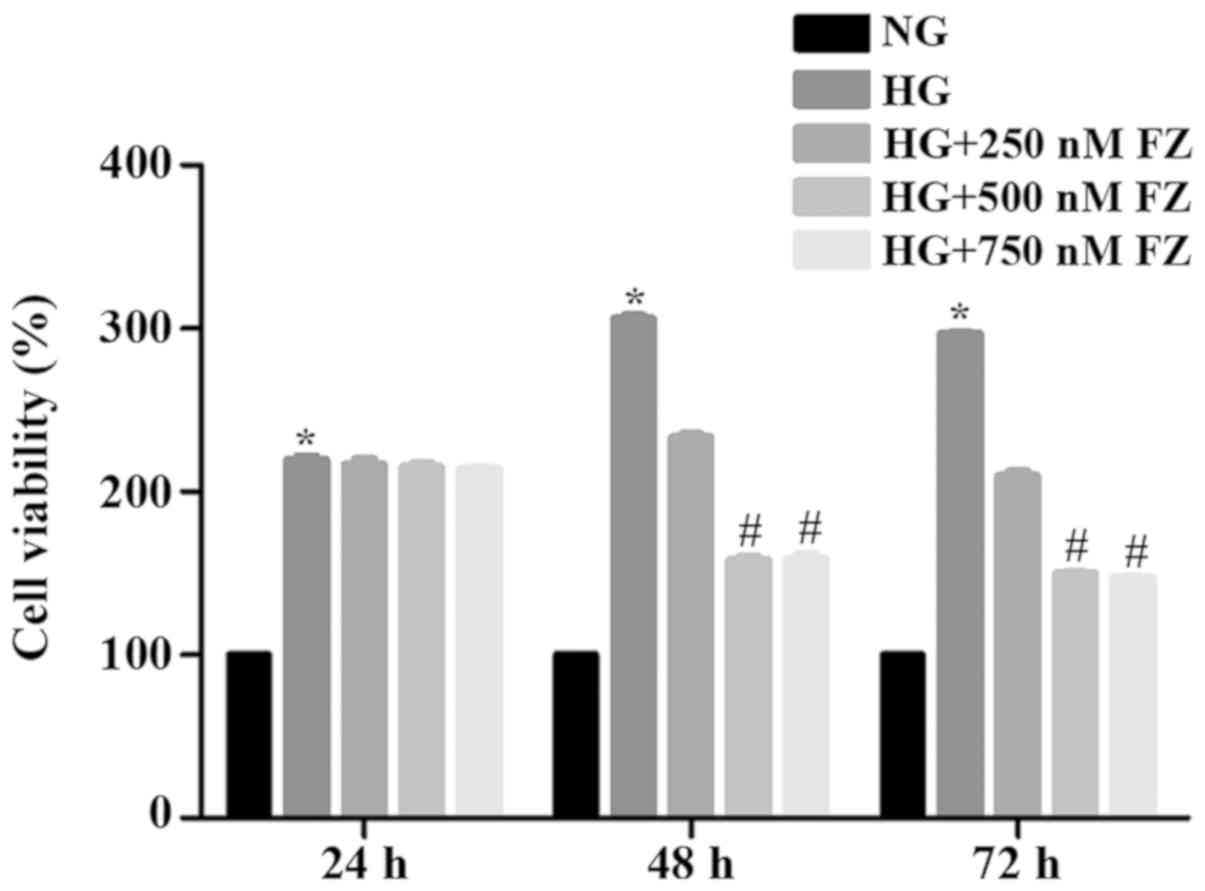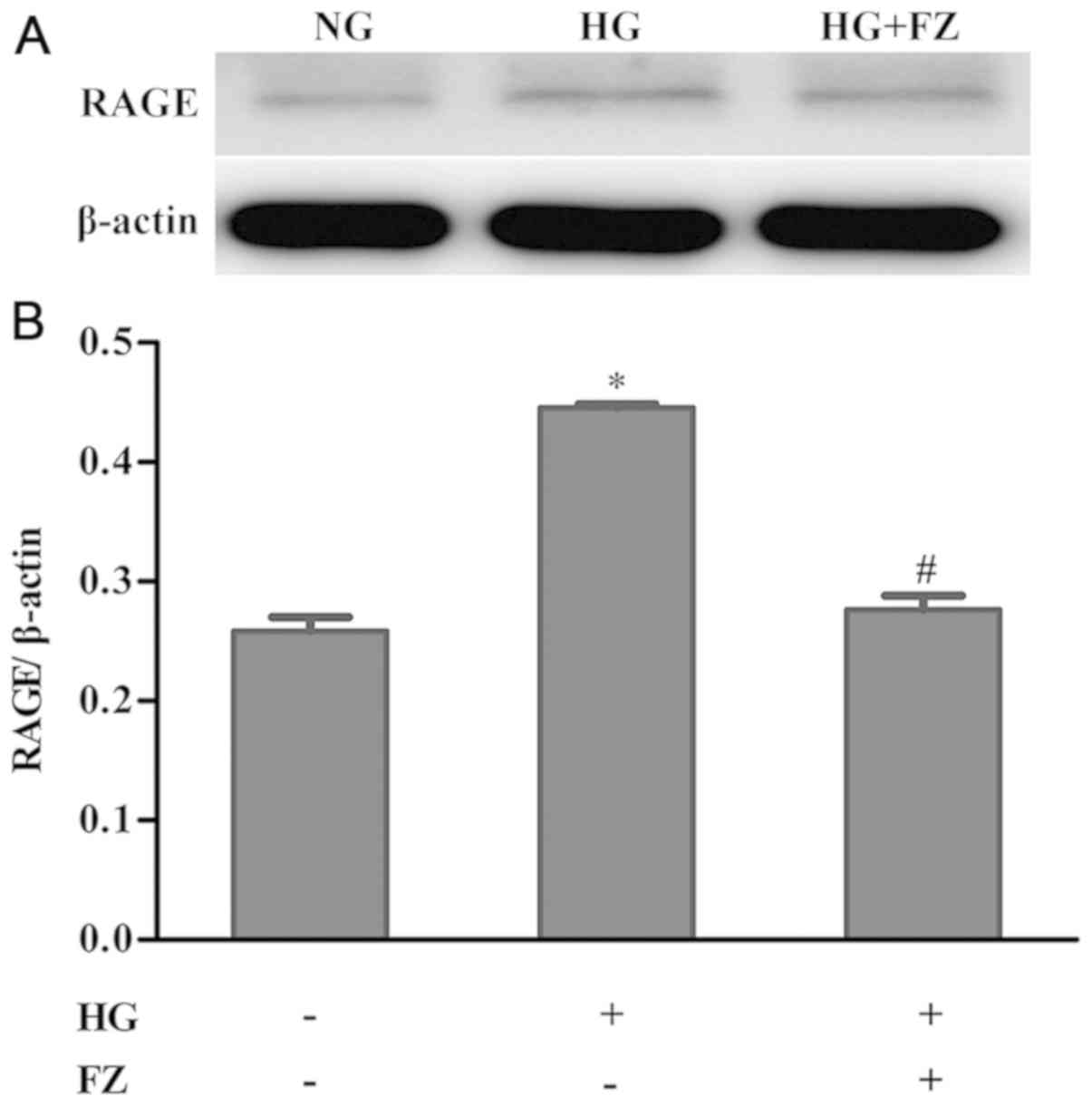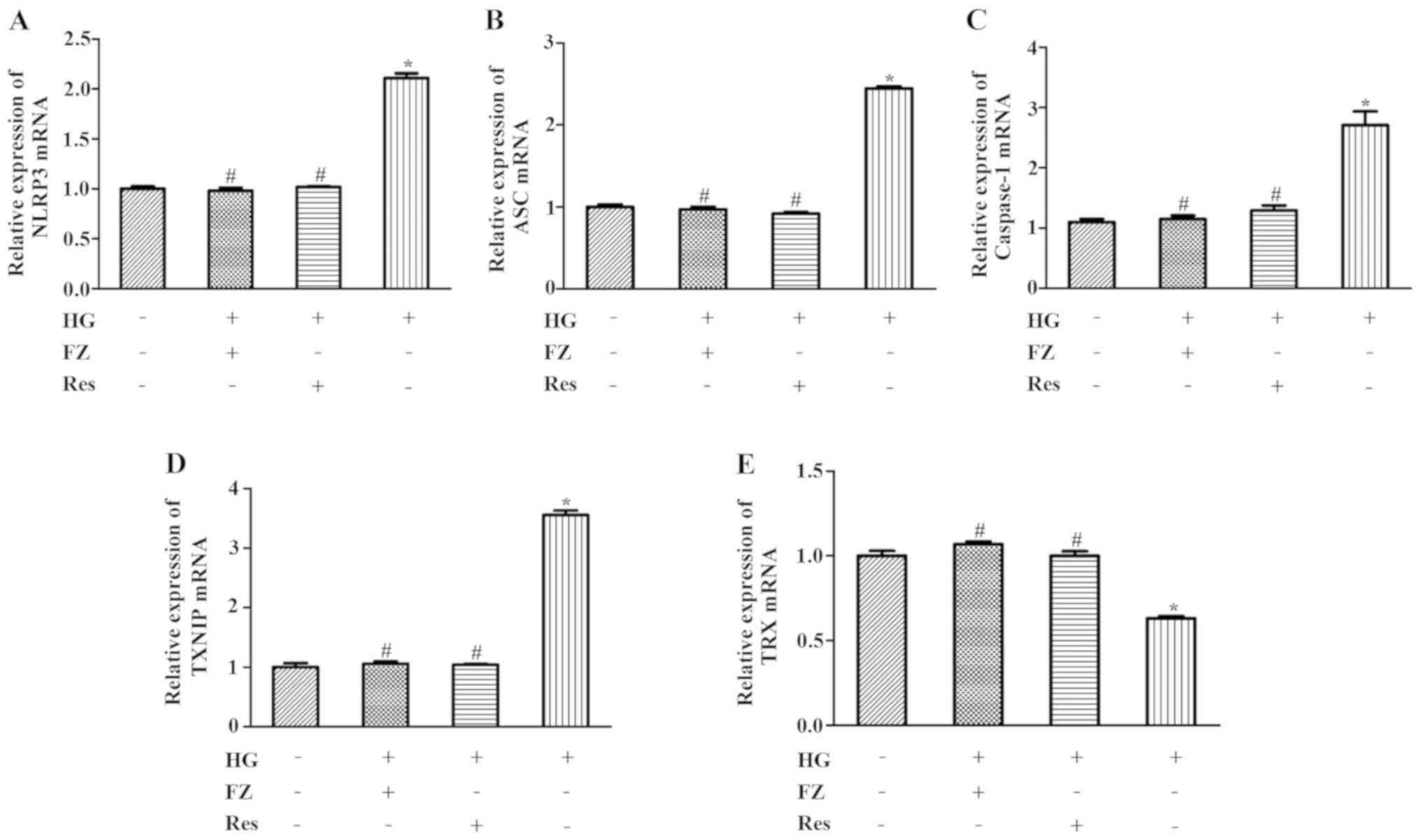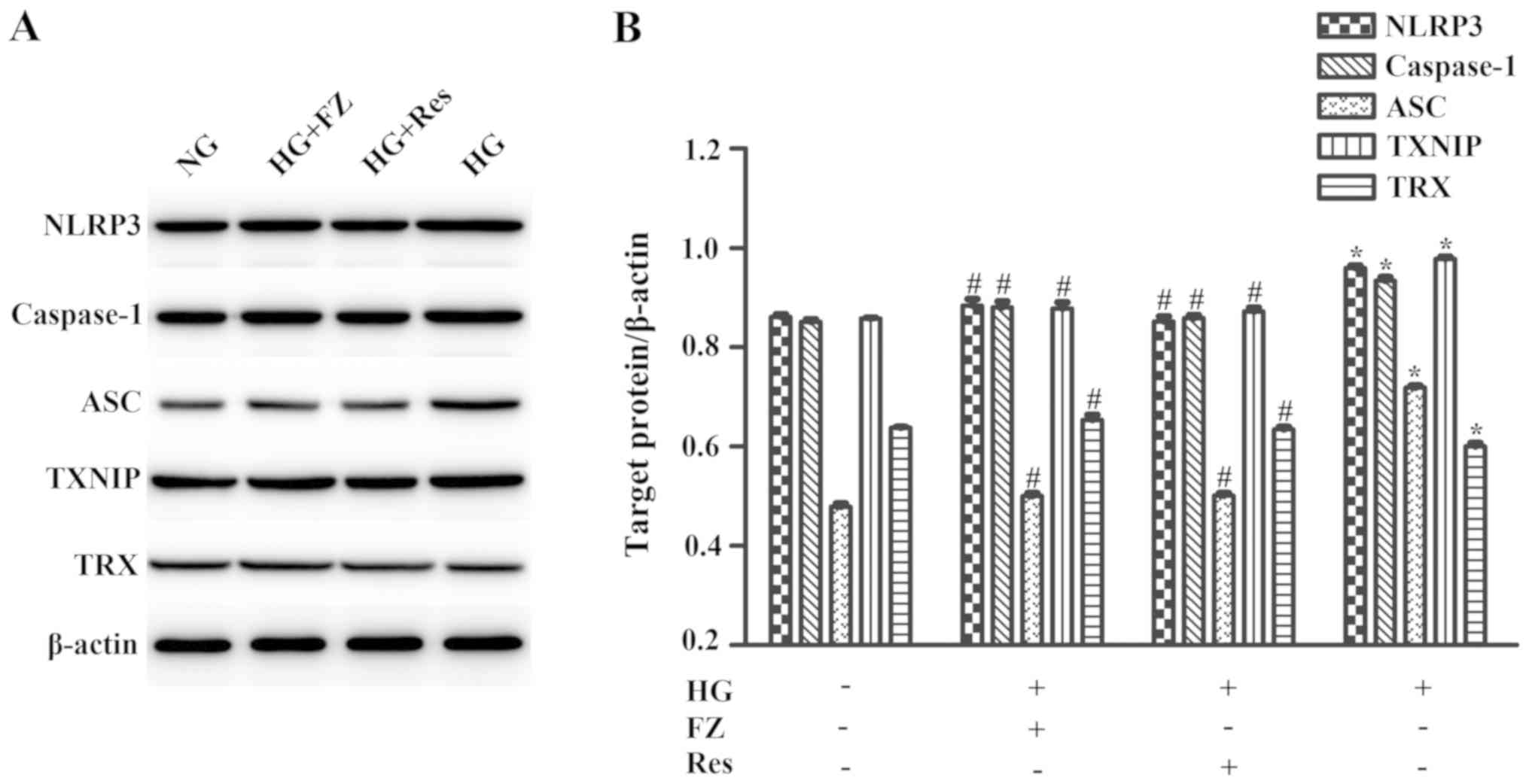|
1
|
Shi Y and Hu FB: The global implications
of diabetes and cancer. Lancet. 383:3255–1948. 2014. View Article : Google Scholar
|
|
2
|
Yamamoto Y and Yamamoto H: RAGE-Mediated
Inflammation, type 2 diabetes, and diabetic vascular complication.
Front Endocrinol (Lausanne). 4:1052013. View Article : Google Scholar : PubMed/NCBI
|
|
3
|
Rübsam A, Parikh S and Fort PE: Role of
Inflammation in diabetic retinopathy. Int J Mol Sci. 19:9422018.
View Article : Google Scholar
|
|
4
|
Yuan Y, Sun H and Sun Z: Advanced
glycation end products (AGEs) increase renal lipid accumulation: A
pathogenic factor of diabetic nephropathy (DN). Lipids Health Dis.
16:1262017. View Article : Google Scholar : PubMed/NCBI
|
|
5
|
Shi L, Yu X, Yang H and Wu X: Advanced
glycation end products induce human corneal epithelial cells
apoptosis through generation of reactive oxygen species and
activation of JNK and p38 MAPK pathways. PLoS One. 8:e667812013.
View Article : Google Scholar : PubMed/NCBI
|
|
6
|
Meloche J, Paulin R, Roy M, Agharazii M
and Bonnet S: Activation of RAGE/STAT3 axis by advanced glycation
endproducts in vascular remodeling diseases. Circulation. 122
(Suppl 21):S159692010.
|
|
7
|
Sanajou D, Haghjo AG, Argani H and Aslani
S: AGE-RAGE axis blockade in diabetic nephropathy: Current status
and future directions. Eur J Pharmacol. 833:158–164. 2018.
View Article : Google Scholar : PubMed/NCBI
|
|
8
|
Sanajou D, Ghorbani Haghjo A, Argani H,
Roshangar L, Rashtchizadeh N, Ahmad SNS, Ashrafi-Jigheh Z and
Bahrambeigi S: Reduction of renal tubular injury with a RAGE
inhibitor FPS-ZM1, valsartan and their combination in
streptozotocin-induced diabetes in the rat. Eur J Pharmacol.
842:40–48. 2019. View Article : Google Scholar : PubMed/NCBI
|
|
9
|
Zhan D, Guo L and Zheng L: Inhibition of
the receptor for advanced glycation promotes proliferation and
repair of human periodontal ligament fibroblasts in response to
high glucose via the NF-kappa B signaling pathway. Arch Oral Biol.
87:86–93. 2018. View Article : Google Scholar : PubMed/NCBI
|
|
10
|
Huang J, Xiong T, Zhang Z, Tan Y and Guo
L: Inhibition of the receptor for advanced glycation inhibits
lipopolysaccharide-mediated High mobility group protein B1 and
Interleukin-6 synthesis in human gingival fibroblasts through the
NF-κB signaling pathway. Arch Oral Biol. 105:81–87. 2019.
View Article : Google Scholar : PubMed/NCBI
|
|
11
|
Graves DT, Ding Z and Yang Y: The impact
of diabetes on periodontal diseases. Periodontol. 82:214–224. 2020.
View Article : Google Scholar
|
|
12
|
Almajwal AM, Alam I, Abulmeaty M, Razak S,
Pawelec G and Alam W: Intake of dietary advanced glycation end
products influences inflammatory markers, Immune phenotypes, and
antiradical capacity of healthy elderly in a little-studied
population. Food Sci Nutr. 8:1046–1057. 2020. View Article : Google Scholar : PubMed/NCBI
|
|
13
|
Yao D, Wang S, Wang M and Lu W:
Renoprotection of dapagliflozin in human renal proximal tubular
cells via the inhibition of the high mobility group box 1receptor
for advanced glycation end productsnuclear factor-κB signaling
pathway. Mol Med Rep. 18:3625–3630. 2018.PubMed/NCBI
|
|
14
|
Chang PC, Chien LY, Yeo JF, Wang YP, Chung
MC, Chong LY, Kuo MY, Chen CH, Chiang HC, Ng BN, et al: Progression
of periodontal destruction and the roles of advanced glycation end
products in experimental diabetes. J Periodontol. 84:379–388. 2013.
View Article : Google Scholar : PubMed/NCBI
|
|
15
|
Bartold PM and Van Dyke TE: Periodontitis:
A host-mediated disruption of microbial homeostasis. Unlearning
learned concepts. Periodontol. 62:203–217. 2013. View Article : Google Scholar
|
|
16
|
Al-Sowygh ZH, Ghani SMA, Sergis K, Vohra F
and Akram Z: Peri-implant conditions and levels of advanced
glycation end products among patients with different glycemic
control. Clin Implant Dent Relat Res. 20:345–351. 2018. View Article : Google Scholar : PubMed/NCBI
|
|
17
|
Dey D, Jingar P, Agrawal S, Shrivastava V,
Bhattacharya A, Manhas J, Garg B, Ansari MT, Mridha AR, Sreenivas
V, et al: Symphytum officinale augments osteogenesis in human bone
marrow-derived mesenchymal stem cells in vitro as they
differentiate into osteoblasts. J Ethnopharmacol. 248:1123292020.
View Article : Google Scholar : PubMed/NCBI
|
|
18
|
Dhanasekaran M, Indumathi S, Rajkumar JS
and Sudarsanam D: Effect of high glucose on extensive culturing of
mesenchymal stem cells derived from subcutaneous fat, omentum fat
and bone marrow. Cell Biochem Funct. 31:20–29. 2013. View Article : Google Scholar : PubMed/NCBI
|
|
19
|
Nonaka K, Kajiura Y, Bando M, Sakamoto E,
Inagaki Y, Lew JH, Naruishi K, Ikuta T, Yoshida K, Kobayashi T, et
al: Advanced glycation end-products increase IL-6 and ICAM-1
expression via RAGE, MAPK and NF-κB pathways in human gingival
fibroblasts. J Periodontal Res. 53:334–344. 2018. View Article : Google Scholar : PubMed/NCBI
|
|
20
|
Thielen L and Shalev A: Diabetes
pathogenic mechanisms and potential new therapies based upon a
novel target called TXNIP. Curr Opin Endocrinol Diabetes Obes.
25:75–80. 2018. View Article : Google Scholar : PubMed/NCBI
|
|
21
|
Gouravani M, Khalili N, Razi S,
Keshavarz-Fathi M, Khalili N and Rezaei N: The NLRP3 inflammasome:
A therapeutic target for inflammation-associated cancers. Expert
Rev Clin Immunol. 16:175–187. 2020. View Article : Google Scholar : PubMed/NCBI
|
|
22
|
Feng H, Gu J, Gou F, Huang W, Gao C, Chen
G, Long Y, Zhou X, Yang M, Liu S, et al: High Glucose and
lipopolysaccharide prime NLRP3 inflammasome via ROS/TXNIP pathway
in mesangial cells. J Diabetes Res. 2016:1–11. 2016. View Article : Google Scholar
|
|
23
|
An N, Gao Y, Si Z, Zhang H, Wang L, Tian
C, Yuan M, Yang X, Li X, Shang H, et al: Regulatory mechanisms of
the NLRP3 inflammasome, a novel immune-inflammatory marker in
cardiovascular diseases. Front Immunol. 10:15922019. View Article : Google Scholar : PubMed/NCBI
|
|
24
|
Matsui T, Nakamura N, Ojima A, Nishino Y
and Yamagishi SI: Sulforaphane reduces advanced glycation end
products (AGEs)-induced inflammation in endothelial cells and rat
aorta. Nutr Metab Cardiovasc Dis. 26:797–807. 2016. View Article : Google Scholar : PubMed/NCBI
|
|
25
|
Saresella M, La Rosa F, Piancone F, Zoppis
M, Marventano I, Calabrese E, Rainone V, Nemni R, Mancuso R and
Clerici M: The NLRP3 and NLRP1 inflammasomes are activated in
Alzheimers disease. Mol Neurodegener. 11:232016. View Article : Google Scholar : PubMed/NCBI
|
|
26
|
Zhao LR, Xing RL, Wang PM, Zhang NS, Yin
SJ, Li XC and Zhang L: NLRP1 and NLRP3
inflammasomes mediate LPS/ATP-induced pyroptosis in knee
osteoarthritis. Mol Med Rep. 17:5463–5469. 2018.PubMed/NCBI
|
|
27
|
Wen H, Gris D, Lei Y, Jha S, Zhang L,
Huang MT, Brickey WJ and Ting JP: Fatty acid-induced NLRP3-ASC
inflammasome activation interferes with insulin signaling. Nat
Immunol. 12:408–415. 2011. View
Article : Google Scholar : PubMed/NCBI
|
|
28
|
Bharti V, Tan H, Zhou H and Wang JF: Txnip
mediates glucocorticoid-activated NLRP3 inflammatory signaling in
mouse microglia. Neurochem Int. 131:1045642019. View Article : Google Scholar : PubMed/NCBI
|
|
29
|
Omar DF, Kamal MM, El-Hefnawy MH and
El-Mesallamy HO: Serum Vitamin D and its upregulated protein,
thioredoxin interacting protein, are associated with beta-cell
dysfunction in adult patients with type 1 and type 2 diabetes. Can
J Diabetes. 42:588–594. 2018. View Article : Google Scholar : PubMed/NCBI
|
|
30
|
Gateva AT, Assyov YS, Velikova T and
Kamenov ZA: Higher levels of thioredoxin interacting protein
(TXNIP) in patients with prediabetes compared to obese
normoglycemic subjects. Diabetes Metabolic Syndrome. 13:734–737.
2019. View Article : Google Scholar : PubMed/NCBI
|
|
31
|
Livak KJ and Schmittgen TD: Analysis of
relative gene expression data using real-time quantitative PCR and
the 2(-Delta Delta C(T)) method. Methods. 25:402–408. 2001.
View Article : Google Scholar : PubMed/NCBI
|
|
32
|
Chiu HC, Fu MM, Yang TS, Fu E, Chiang CY,
Tu HP, Chin YT, Lin FG and Shih KC: Effect of high glucose,
Porphyromonas gingivalis lipopolysaccharide and advanced glycation
endproducts on production of interleukin-6/-8 by gingival
fibroblasts. J Periodontal Res. 52:268–276. 2017. View Article : Google Scholar : PubMed/NCBI
|
|
33
|
Lalla E, Lamster IB, Stern DM and Schmidt
AM: Receptor for advanced glycation end products, inflammation, and
accelerated periodontal disease in diabetes: Mechanisms and
insights into therapeutic modalities. Ann Periodontol. 6:113–118.
2001. View Article : Google Scholar : PubMed/NCBI
|
|
34
|
Daniele G, Guardado Mendoza R, Winnier D,
Fiorentino TV, Pengou Z, Cornell J, Andreozzi F, Jenkinson C,
Cersosimo E, Federici M, et al: The inflammatory status score
including IL-6, TNF-α, osteopontin, fractalkine, MCP-1 and
adiponectin underlies whole-body insulin resistance and
hyperglycemia in type 2 diabetes mellitus. Acta Diabetol.
51:123–131. 2014. View Article : Google Scholar : PubMed/NCBI
|
|
35
|
Han Y, Xu X, Tang C, Gao P, Chen X, Xiong
X, Yang M, Yang S, Zhu X, Yuan S, et al: Reactive oxygen species
promote tubular injury in diabetic nephropathy: The role of the
mitochondrial ros-txnip-nlrp3 biological axis. Redox Biol.
16:32–46. 2018. View Article : Google Scholar : PubMed/NCBI
|
|
36
|
Taylor JJ, Preshaw PM and Lalla E: A
review of the evidence for pathogenic mechanisms that may link
periodontitis and diabetes. J Clin Periodontol. 40 (4
Suppl):S113–S134. 2013. View Article : Google Scholar : PubMed/NCBI
|
|
37
|
Akdis M, Aab A, Altunbulakli C, Azkur K,
Costa RA, Crameri R, Duan S, Eiwegger T, Eljaszewicz A, Ferstl R,
et al: Interleukins (from IL-1 to IL-38), interferons, transforming
growth factor β, and TNF-α: Receptors, functions, and roles in
diseases. J Allergy Clin Immunol. 138:984–1010. 2016. View Article : Google Scholar : PubMed/NCBI
|
|
38
|
Zheng DH, Han ZQ, Wang XX, Ma D and Zhang
J: Erythropoietin attenuates high glucose-induced oxidative stress
and inhibition of osteogenic differentiation in periodontal
ligament stem cell (PDLSCs). Chem Biol Interact. 305:40–47. 2019.
View Article : Google Scholar : PubMed/NCBI
|
|
39
|
Kang K, Chuai JB, Xie BD, Li JZ, Qu H, Wu
H, Fang SH, Cui JJ, Xiu LL, Han JC, et al: Mesenchymal stromal
cells from patients with cyanotic congenital heart disease are
optimal candidate for cardiac tissue engineering. Biomaterials.
230:1195742020. View Article : Google Scholar : PubMed/NCBI
|
|
40
|
Dong H, Wang Z, Chen Y and Li Y:
Protective effects of bone Marrow-derived mesenchymal stem cells on
insulin secretion and inflammation in the treatment of severe acute
pancreatitis in rats. Transplant Proc. 52:333–344. 2020. View Article : Google Scholar : PubMed/NCBI
|
|
41
|
Li H, Zhou HL, Guo F, Wang Q and Li W: The
effects of 25-hydroxyvitamin D3 on the activation of
NLRP3 inflammasome and inflammatory response of bone marrow
mesenchymal stem cells from the diabetic rats. J Pract Stomatol.
34:11–15. 2018.
|
|
42
|
Liao F, Liu Y, Liu HH, Hu J, Zhao S and
Yang SM: Effect of Angelica sinensis polysaccharide on the
osteogenic differentiation of bone marrow mesenchymal stem cells of
rats with high glucose levels. Hua Xi Kou Qiang Yi Xue Za Zhi.
37:193–199. 2019.(In Chinese). PubMed/NCBI
|
|
43
|
Li H, Wang D, Chen Y and Yang M:
β-Caryophyllene inhibits high glucose-induced oxidative stress,
inflammation and extracellular matrix accumulation in mesangial
cells. Int Immunopharmacol. 84:1065562020. View Article : Google Scholar : PubMed/NCBI
|
|
44
|
Soydas T, Yaprak Sarac E, Cinar S, Dogan
S, Solakoglu S, Tuncdemir M and Kanigur Sultuybek G: The protective
effects of metformin in an in vitro model of aging 3T3 fibroblast
under the high glucose conditions. J Physiol Biochem. 74:273–281.
2018. View Article : Google Scholar : PubMed/NCBI
|
|
45
|
Wu J, Lu K, Zhu M, Xie X, Ding Y, Shao X,
Chen Y, Liu J, Xu M, Xu Y, et al: miR-485 suppresses inflammation
and proliferation of mesangial cells in an in vitro model of
diabetic nephropathy by targeting NOX5. Biochem Biophys Res Commun.
521:984–990. 2020. View Article : Google Scholar : PubMed/NCBI
|
|
46
|
Wang Z, Maruyama K, Sakisaka Y, Suzuki S,
Tada H, Suto M, Saito M, Yamada S and Nemoto E: Cyclic stretch
force induces periodontal ligament cells to secrete exosomes that
suppress IL-1β production through the inhibition of the NF-κB
signaling pathway in macrophages. Front Immunol. 10:13102019.
View Article : Google Scholar : PubMed/NCBI
|
|
47
|
Yang L, Wu L, Zhang X, Hu Y, Fan Y and Ma
J: 1,25(OH)2D3/VDR attenuates high glucoseinduced
epithelialmesenchymal transition in human peritoneal mesothelial
cells via the TGFβ/Smad3 pathway. Mol Med Rep. 15:2273–2279. 2017.
View Article : Google Scholar : PubMed/NCBI
|
|
48
|
Dong F, Dong S, Liang Y, Wang K, Qin Y and
Zhao X: miR-20b inhibits the senescence of human umbilical vein
endothelial cells through regulating the Wnt/β-catenin pathway via
the TXNIP/NLRP3 axis. Int J Mol Med. 45:847–857. 2020.PubMed/NCBI
|
|
49
|
Lu WL, Song DZ, Yue JL, Wang TT, Zhou XD,
Zhang P, Zhang L and Huang DM: NLRP3 inflammasome may regulate
inflammatory response of human periodontal ligament fibroblasts in
an apoptosis-associated speck-like protein containing a CARD
(ASC)-dependent manner. Int Endod J. 50:967–975. 2017. View Article : Google Scholar : PubMed/NCBI
|
|
50
|
Bui FQ, Johnson L, Roberts J, Hung SC, Lee
J, Atanasova KR, Huang PR, Yilmaz Ö and Ojcius DM: Fusobacterium
nucleatum infection of gingival epithelial cells leads to NLRP3
inflammasome-dependent secretion of IL-1β and the danger signals
ASC and HMGB1. Cell Microbiol. 18:970–981. 2016. View Article : Google Scholar : PubMed/NCBI
|
|
51
|
Szpigel A, Hainault I, Carlier A,
Venteclef N, Batto AF, Hajduch E, Bernard C, Ktorza A, Gautier JF,
Ferré P, et al: Lipid environment induces ER stress, TXNIP
expression and inflammation in immune cells of individuals with
type 2 diabetes. Diabetologia. 61:399–412. 2018. View Article : Google Scholar : PubMed/NCBI
|
|
52
|
Lu L, Lu Q, Chen W, Li J, Li C and Zheng
Z: Vitamin D3 Protects against diabetic retinopathy by
inhibiting high-glucose-induced activation of the ROS/TXNIP/NLRP3
inflammasome pathway. J Diabetes Res. 2018:81935232018. View Article : Google Scholar : PubMed/NCBI
|
|
53
|
Yi X, Zhang L, Lu W, Tan X, Yue J, Wang P,
Xu W, Ye L and Huang D: The effect of NLRP inflammasome on the
regulation of AGEs-induced inflammatory response in human
periodontal ligament cells. J Periodontal Res. 54:681–689. 2019.
View Article : Google Scholar : PubMed/NCBI
|
|
54
|
Bedarida T, Baron S, Vibert F, Ayer A,
Henrion D, Thioulouse E, Marchiol C, Beaudeux JL, Cottart CH and
Nivet-Antoine V: Resveratrol decreases TXNIP mRNA and protein
nuclear expressions with an arterial function improvement in old
mice. J Gerontol A Biol Sci Med Sci. 71:720–729. 2016. View Article : Google Scholar : PubMed/NCBI
|
|
55
|
Choe D, Palsson B and Cho BK: STATR: A
simple analysis pipeline of Ribo-Seq in bacteria. J Microbiol.
58:217–226. 2020. View Article : Google Scholar : PubMed/NCBI
|
|
56
|
Jeong Y, Kim JN, Kim MW, Bucca G, Cho S,
Yoon YJ, Kim BG, Roe JH, Kim SC, Smith CP, et al: The dynamic
transcriptional and translational landscape of the model antibiotic
producer Streptomyces coelicolor. Nat Commun. 7:116052016.
View Article : Google Scholar : PubMed/NCBI
|
|
57
|
Liu Y, Beyer A and Aebersold R: On the
dependency of cellular protein levels on mRNA abundance. Cell.
165:535–550. 2016. View Article : Google Scholar : PubMed/NCBI
|
|
58
|
Koussounadis A, Langdon SP, Um IH,
Harrison DJ and Smith VA: Relationship between differentially
expressed mRNA and mRNA-protein correlations in a xenograft model
system. Sci Rep. 5:107752015. View Article : Google Scholar : PubMed/NCBI
|
|
59
|
Schwanhäusser B, Busse D, Li N, Dittmar G,
Schuchhardt J, Wolf J, Chen W and Selbach M: Global quantification
of mammalian gene expression control. Nature. 473:337–342. 2011.
View Article : Google Scholar : PubMed/NCBI
|
|
60
|
Surkova S, Sokolkova A, Kozlov K, Nuzhdin
SV and Samsonova M: Quantitative analysis reveals genotype- and
domain-specific differences between mRNA and protein expression of
segmentation genes in Drosophila. Dev Biol. 448:48–58. 2019.
View Article : Google Scholar : PubMed/NCBI
|
|
61
|
Wu X, Zhao W, Cui Q and Zhou Y:
Computational screening of potential regulators for mRNA-protein
expression level discrepancy. Biochem Biophys Res Commun.
523:196–201. 2020. View Article : Google Scholar : PubMed/NCBI
|



















